Bennemann K.H., Ketterson J.B. Superconductivity: Volume 1: Conventional and Unconventional Superconductors; Volume 2: Novel Superconductors
Подождите немного. Документ загружается.

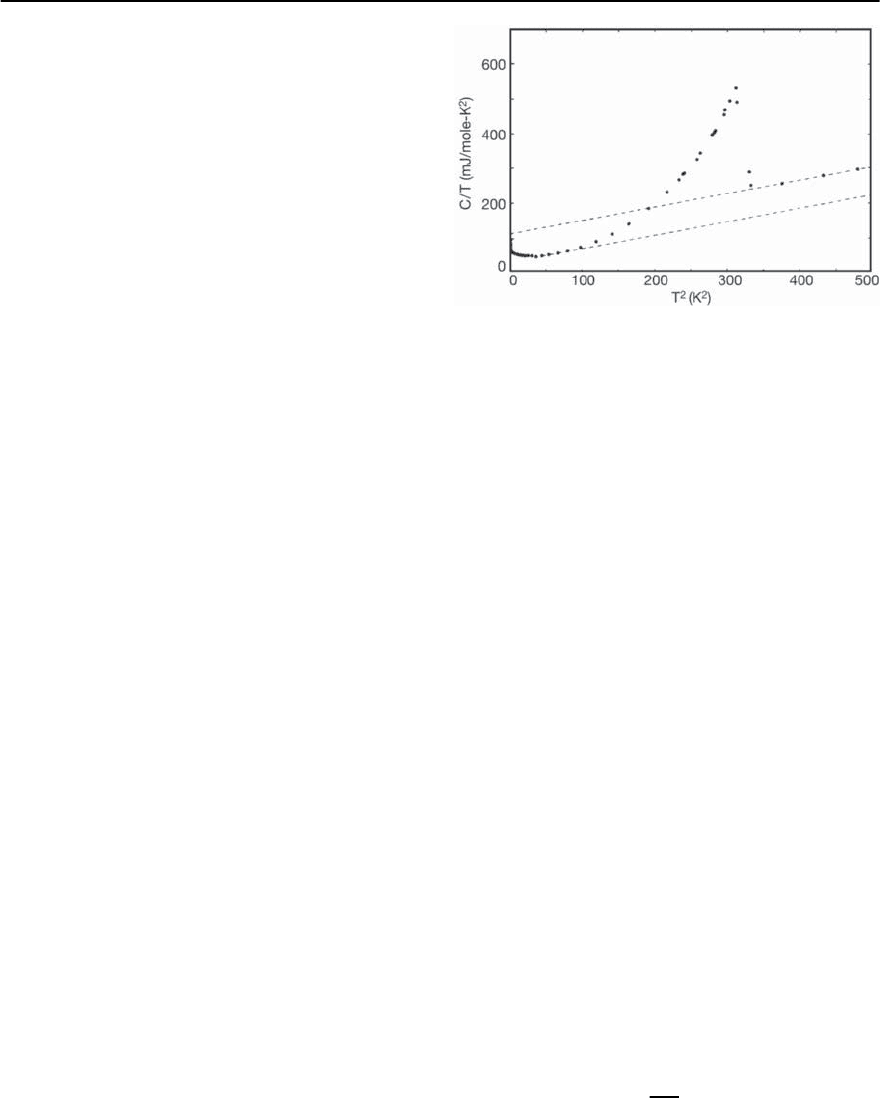
1080 P.S. Riseborough,G.M. Schmiedeshoff,and J.L.Smith
crease in the quasi-particle scattering rate consis-
tent with the observations in the superconducting
state of URu
2
Si
2
[212]. The appearance of de Haas–
van Alphen oscillations in the superconducting state
is surprising since it undermines a commonly held
belief that observability of the oscillations is a sig-
nature of the existence of a sharply defined Fermi
surface and the long lifetime of the quasi-particles.
Furthermore, it is surprising as it definitively shows
that such oscillations can also be observed in non-
Fermi-liquid states.
Magnetic Instabilities
Several of the heavy-fermion materials undergo in-
stabilities to magnetically ordered states at lower
temperatures. The most frequently found type of
ordering is antiferromagnetic, however, ferromag-
netic phases have been identified in UGe
2
,URhGe
CeRu
2
Ge
2
,CeGe
2
,andCeSi
x
.Thevaluesof found
from extrapolation above the ordering temperatures
are generally about a factor of 1.2 to 3 times higher
than the values found from extrapolating below
the ordering temperatures. This indicates that the
antiferromagnetic order may have produced a par-
tial gapping of the Fermi surfaces.Exceptions to this
are given by CeAl
3
,UCu
5
and UPt
3
,wheretheex-
trapolated values are larger in the magnetically
ordered phases. These findings are consistent with
the general observation that the entropy found by
integrating below the ordering temperature is about
30% less than entropy expected from a simple Fermi
liquid picture, i.e., may still be growing below T
N
and the Fermi liquid may have not been completely
formed when T has been decreased to T
N
.
The values of the ordered moments are smaller
than those associated with the free ion values (see Ta-
ble 19.10).This is sometimes attributed to the screen-
ing of the f moments by the conduction electrons.
However, in view of Nozi`eres arguments for Ce com-
pounds and the existence of reduced moment or-
dering in U compounds, it seems apparent that the
itinerant nature of the f electrons is involved in the
reduction of the moments.In some compounds such
as CeAl
3
andURu
2
Si
2
,the magnetic ordering appears
to be inhomogeneous,only occurring in a small frac-
Fig. 19.36. The specific heat jump of the “hidden order”
phase transition of URu
2
Si
2
. The specific heat ratio C/T is
plotted as a function of T
2
. A mean field-like jump occurs
at T
N
≈ 17.5 K which isassociated with the“hidden order”
phase transition. [After Maple et al. [21]]
tion of the sample volume [224]. It seems likely that
these samples are also inhomogeneous. The magni-
tude of the moments on the atoms in the magnet-
ically ordered volume can be large, of the order of
0.5
B
per f atom but the moment averaged over the
sample can be as small as 0.03
B
per f atom,as found
for URu
2
Si
2
. It has been found [225] that in URu
2
Si
2
,
application of pressures of up to 1.5GPaproduces
an increase in the size of the ordered moment to a
valueoftheorderof0.25
B
per U atom but only
produces a slight increase in T
N
.Themagneticor-
dering shows up in the specific heat of CeAl
3
as a
faint and sample dependent anomaly at the ordering
temperature that considerably increases in magni-
tude on dilution. As shown in Fig. 19.36, the spe-
cific heat jump observed in stoichiometric URu
2
Si
2
is quite large [20, 21]. The small magnitude of the
volume averaged ordered moment in URu
2
Si
2
seems
inconsistent with the large value of the entropy as-
sociated with the specific heat anomaly at T
N
.The
specific heat jump is about 5.82 J/mole-K, and the
entropy S associated with the anomaly has a mag-
nitude of about 0.17 Nk
B
ln 2.Ontheother hand,Lan-
dau mean-field theory suggests that the magnitude
of the entropy of the transition should be of the or-
der of
S ∼ Nk
B
sat
eff
2
, (19.139)

19 Heavy-Fermion Superconductivity 1081
Table 19.10.Properties of the magnetically ordered state
Material T
N
Ordered Moment M
(K)(
B
)(mJK
−2
mole f ion
−1
)
CeAl
3
1.6 – 1300
CeCu
2
Si
2
0.8 ∼ 0.1 1000
UCd
11
5 – 250
U
2
Zn
17
9.7 0.8 200
UPt
3
5.0 0.02 450
UPd
2
Al
3
14.5 0.85 150
URu
2
Si
2
17.5 – 65
UNi
2
Al
3
4.6 0.24 120
UGe
2
T
c
(P=1GPa)=34 M(P = 0) = 1.4 –
CePd
2
Si
2
10.2 0.7 250
CeRh
2
Si
2
36 1.8 21
CeIn
3
10.2 0.65 100
CeRhIn
5
(P=0) 3.8 0.37 60
where
sat
is the T = 0 saturation value of the sub-
lattice magnetization; and
eff
is the paramagnetic
moment (
eff
≈ 3.51
B
), as obtained from fitting
the susceptibilityabove T
N
to a Curie–Weiss law.The
large discrepancy between the observed and inferred
magnitudes of the anomalous entropy has been taken
as indicating that another type of ordering occurs
simultaneously with the antiferromagnetism. How-
ever, although the other type of ordering has been
searched for, it has not yet been identified.
An alternate paradigm for heavy-fermion materi-
als is provided by the model of a highly enhanced
Fermi liquid close to a quantum criticalpoint.In this
picture, the large enhancements are caused by the
slow, large amplitude, critical magnetic fluctuations.
Duetothecloseproximityofthecriticalpoint,one
may expect various physical quantities to obey scal-
ing laws [74]. In this case, one expects that the prop-
erties may be expressed in terms of the q
dependent
magnetic susceptibility (q
, T) which expresses the
response of the system to a staggered magnetic field
H(q
). The absence of a large (0, 0)/ ratio indi-
cates that the dominant magnetic fluctuations that
occur are not localized around q =0.Thisisconsis-
tent with the observation that most heavy-fermion
systems undergo instabilities to antiferromagnetic
phases. Likewise, since the transport scattering rate
is dominated by processes involving large scattering
angles due to the weighting factor of (1 − cos),
measurements of transport properties might also be
expected to provide information on the magnitude of
the wave-vectors of the magnetic fluctuations in the
absence of competing instabilities and complicated
multi-sheeted Fermi surfaces.
19.3.2 Transport Properties
Electrical Resist ivity
The room temperature resistivitiesof heavy-fermion
compounds are quite large, of the order of 100
§cm
−1
, most probably due to spin disorder scat-
tering. As seen in Fig. 19.37, the resistivity of some
materialssuchasCeCu
2
Si
2
,CeAl
3
,UBe
13
and U
2
Zn
17
,
shows an increase with decreasing temperature. This
type of temperature dependence is unusual for sim-
ple metals but is characteristic of the Kondo effect
often found in materials containing isolated and dis-
ordered magnetic impurities.In this subset of heavy-
fermion materials, the upturn in the resistivity fol-
lows a logarithmic temperature dependence that re-
sults from the conduction electrons resonantly spin-
flip scattering from isolated magnetic impurities, as
calculated in third order perturbation theory [163].
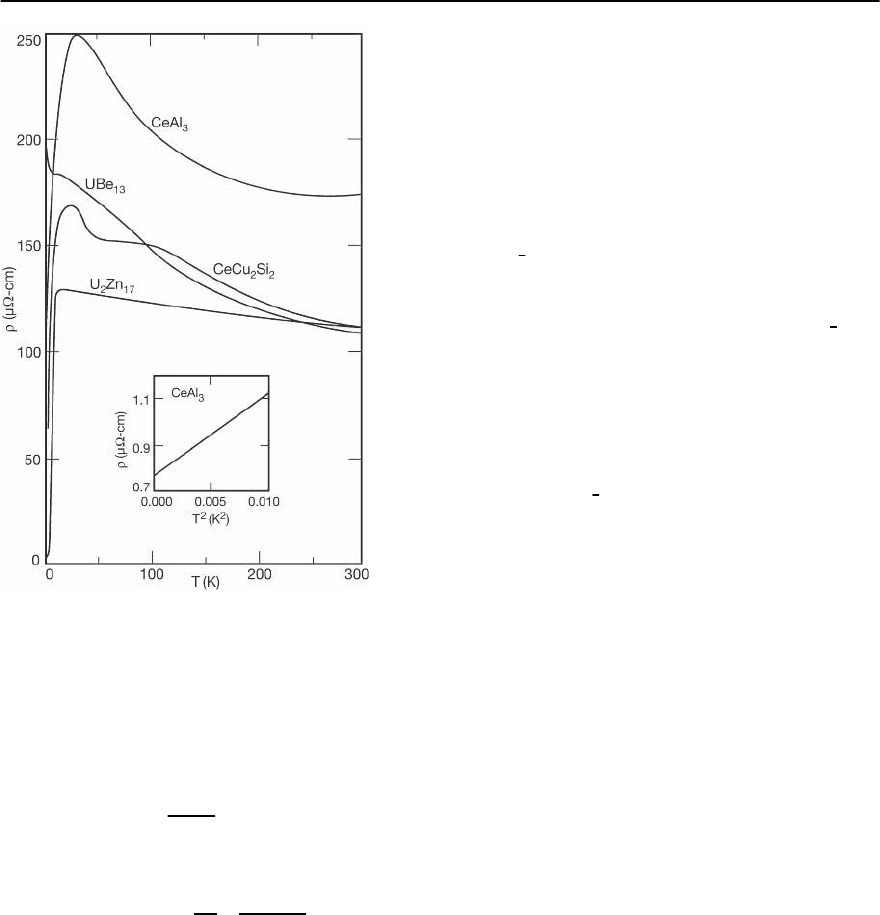
1082 P.S. Riseborough,G.M. Schmiedeshoff,and J.L.Smith
Fig. 19.37. The temperature dependence of the electrical re-
sistivity of the heavy-fermion compounds U
2
Zn
17
,CeAl
3
,
CeCu
2
Si
2
and UBe
13
.Theinset shows the low temperature
T
2
variation of the resistivity found in CeAl
3
If, at high T,the conduction electrons are assumed to
be scattered by localized moments, the conductivity
is given by
(T)=
e
2
k
3
F
3
2
m
I
(0)
, (19.140)
where
I
(n)
=
+∞
−∞
dE
−
∂f
∂E
E
n
Im£
c
(E)
(19.141)
and where £
c
(E) is the conduction electron self-
energy. For independent local moments the imagi-
nary part of the self-energy is given by
Im£
c
(E)=|V|
2
f
(E, T) , (19.142)
where
f
(E, T) is the temperature dependent f den-
sity of states, and V is the hybridization matrix el-
ements. For T < T
K
, a narrow (possibly crystal
field split) Kondo resonance forms at an energy T
K
above . The temperature dependent crystal-field
split
f
(E, T) expected from the single-impurityAn-
derson model is shown in Fig. 19.38. Thus, the resis-
tivity is expected to reflect any crystal-field splitting
that may be present. As seen in Fig. 19.39, there are
two peaks in the resistivity of CeCu
2
Si
2
[226] both of
which can be attributed to spinflip scattering from
the J =
5
2
crystal field split states of the Ce
3+
ion.The
position of the higher temperature peak (∼ 160 K)
is associated with the crystal field splitting between
the multiplets of the lowestspin-orbit split J =
5
2
level
of the Ce
3+
ions. The 160 K peak is produced by the
freezing out of transitions into the higher crystal field
split states [167,227].For temperatures greater than
the crystal field splitting, the conduction electrons
participate in scattering events in which the Ce
3+
ions are scattered between all the crystal field split
states of the J =
5
2
. However, for temperatures below
the crystal field splitting of the lowest multiplet, only
the lowest crystal field multiplet contributes to the
scattering rate. Hence, as the coefficient of the ln T
term in the resistivity is determined by the effective
degeneracy of the local moments, the drop in effec-
tive degeneracy produces the second peak in (T)
for CeCu
2
Si
2
. In contrast to Ce systems [228–232],
U based heavy-fermion systems show little evidence
of crystal field splittings or, if they do, are am-
biguous [233,235,236]. For single impurity spinflip
scattering, the logarithmic temperature variation of
the resistivity is expected to cease near T
K
,below
which the resistivity should show a Fermi liquid like
(T)=(0) − AT
2
temperature variation with a re-
sistivity maximum only occurring at zero tempera-
ture. In contrast to theoretical results for the single-
impurity Kondo model, for heavy-fermion materials
such as CeAl
3
,CeCu
2
Si
2
,CeCu
6
,URu
2
Si
2
and UBe
13
,
the observed Kondoesque increase in the resistiv-
ity is followed by a rapid decrease with decreasing
temperature. The decrease is often attributed to the
onset of coherence in the set of f moments.Above the
coherence temperature, the f moments are assumed
to be independent and have uncorrelated fluctua-
tions whereas at low temperatures, the moments are
assumed to approximately align over large spatial
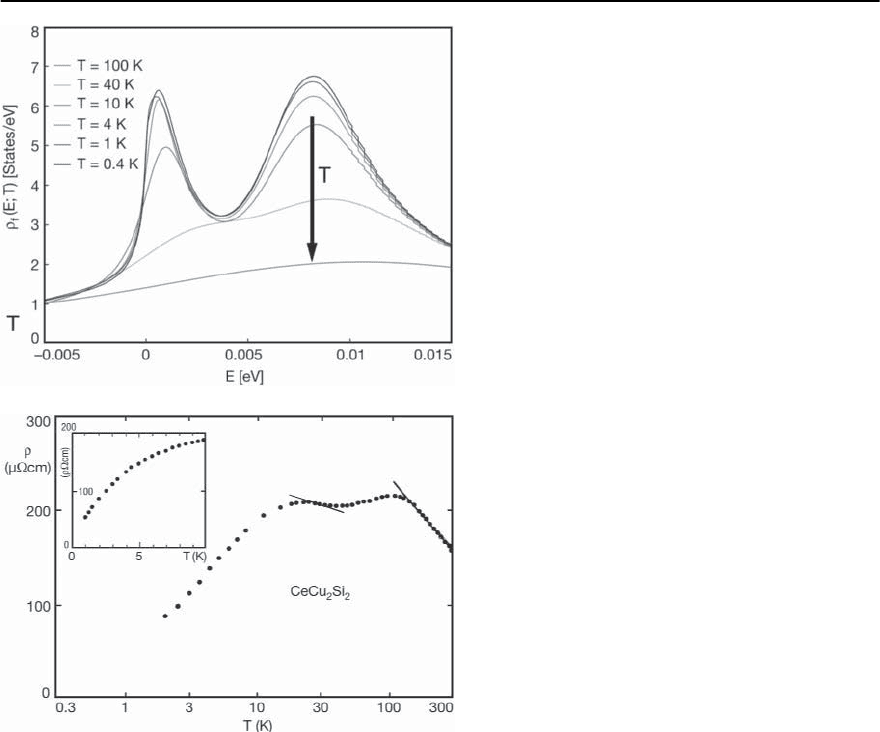
19 Heavy-Fermion Superconductivity 1083
Fig. 19.38. The calculated energy dependence of the
f electron density of states
f
(E, T)forthesingle-
impurity Anderson model, at various temperatures.
The calculation is appropriate to describe a Ce ion in a
cubic environment.The temperature dependent Kondo
peak, above the Fermi energy, is split by the crystalline
electric field. The spectrum was calculated using the
non-crossing approximation
Fig. 19.39. Thetemperature dependenceof theelectrical
resistivity of CeCu
2
Si
2
, plotted on a logarithmic tem-
perature scale. The two regions where the resistivity
shows an approximate ln T dependence are indicated
by the solid lines. [After Franz et al.[226]]
regions. The fluctuations responsible for preventing
perfect alignment are assumed to have a collective
character, and it is these fluctuations that are as-
sumed to provide the dominant inelastic scattering
process that freezes out as T is reduced to zero. In
URu
2
Si
2
, the broad peak in the resistivity occurs at
50 K where it attains a value of 3000 §cms and then
shows a rapid decrease at lower temperatures. The
decrease is briefly interrupted at T
N
=17.5K,where
the resistivity shows a slight,but abrupt,increasedue
to ordering [21].The increase in the resistivity is un-
derstood in terms of a partial gapping of the Fermi
surface and is consistent with the change in the ex-
trapolated C/T ratio from 112 mJ/mole K
2
above T
N
to 65.5 mJ/mole K
2
below T
N
.InUBe
13
, the peak in
the resistivity is remarkably sharp; the peak occurs
at 2.5 K and has a value of the order of 200 §cm.
On the other hand, UPt
3
and UAl
2
do not show Kon-
doesque maxima in the resistivities but just decrease
with decreasing temperature. The low temperature
resistivities of CeCu
6
,CeAl
3
,UAl
2
,UPt
3
,UGe
2
under
pressure andYbBiPt show (T)=(0)+AT
2
temper-
ature variations characteristic of electron–electron
scattering. The coefficients of the T
2
terms are enor-
mous as they seem to scale with the square of the
term in the specific heat [237],in agreement with the
argument involving highly enhancedquasi-particles.
The large A coefficients are, therefore, taken as in-
dicating the mutual scattering of quasi-particles in
a highly enhanced Fermi liquid. Although a large

1084 P.S. Riseborough,G.M. Schmiedeshoff,and J.L.Smith
T
2
coefficient was also observed in the resistivity of
CeCu
2
Si
2
, it has been suggested that this is not a true
manifestation of the existence of a Fermi liquid in
that by suppressing the superconductivity through
the application of a magnetic field, a T
3/2
tempera-
ture variation is observed in S type samples [193].
Since the specific heat of S type samples also shows
non-Fermi-liquidlikebehavior,it hasbeensuggested
that the non-Fermi-liquid is caused by the existence
of a quantum critical point, but could also be due to
structural disorder [194].
The residual resistivities (0) of heavy-fermion
materials are sensitive to the presence of disorder
and impurities.Oftenthe residual resistivityis found
to have a magnitude comparable to that of common
metals with similar levels of impurities. However,
in cases where the f ion is substituted by a non-
magnetic impurity, the resulting residual resistivi-
ties are quite large. This has led to the concept of the
Kondo hole in which a substitutional non-magnetic
impurity at an f site of a heavy-fermion system pro-
duces a scattering phase shift of
2
relative to the
coherent resonant scattering of the lattice of f ions.
Since the difference of the phase shifts is close to
2
, the scattering of the substitutional non-magnetic
impurity is similar to the scattering produced by a
magnetic impurity in a simple metal [238].Basically,
the large residual resistance of a Kondo hole in a
heavy-fermion metal can be attributed as being due
to the persistence of the large mass renormalization
of the current carrying quasi-particle in the pres-
ence of disorder. This is to be expected as current
can only be carried by states that are spatially ex-
tended. On the other hand, the scattering time at the
site of the non-magnetic impurity is not expected
to be renormalized by the mass enhancement fac-
tor as the scattering is purely a local phenomenon
taking place on the non-magnetic impurity ion. The
identification of the wave function renormalization
Z with the ratio /k
B
T
K
then yields a residual resis-
tivity that is governed by the characteristic Kondo
scattering rate of the missing f ion.
Magneto-Resistance
Since large amplitude fluctuations of the magnetic
moments are assumed to be responsible for the trans-
port scattering rate, the field dependence of the re-
sistivity or longitudinal magneto-resistance should
be quite illuminating. Basically, the application of a
sufficiently large magnetic field could result in a par-
tial ordering of the moments thereby suppressing the
magnetic fluctuations and producing a reduction of
the resistivity. This expectation is borne out in ex-
periments on CeCu
6
[239] and in the normal state of
UBe
13
[240,241]which show largenegative magneto-
resistances, (H),
(H)
(0)
=
(H)−(0)
(0)
. (19.143)
On the other hand, for both CeAl
3
[242,243] and
CeCu
2
Si
2
[242], the magneto-resistance is negative
at sufficiently high temperatures and changes sign
at temperatures comparable to the cross-over tem-
perature. The high temperature magneto-resistance
shows a scaling with field which can be understood
in terms of models of magnetic scattering from sin-
gle impurities [244,245] in which Zeeman splitting
suppresses the incoherent resonant scattering. How-
ever, the single impurity models fail at low tem-
peratures where the incoherent magnetic scattering
ceases [240,246]. In this low temperature limit, one
expects that the resistivity will be dominated by im-
purity scattering and that the magneto-resistance
should follow the scaling implied by Koehler’s law.
In UBe
13
, the low temperature magneto-resistance
is very large, negative, and anisotropic, which is in-
dicative that the magnetic fluctuations responsible
for the scattering of the conduction electrons are
also anisotropic [247]. For UPt
3
and UAl
2
,which
have no maxima in the resistivity, the magneto-
resistances are positive [248]. A positive transverse
magneto-resistance is often found in common met-
als with multi-sheeted Fermi surfaces. In these com-
mon metals, the Lorentz force produces different
shifts of the various sheets of Fermi surface that only
produce a zero transverse current when their con-
tributions are combined. The Lorentz force acting
on the transverse current components produces a
positive magneto-resistance. Therefore, the positive
magneto-resistances found at low temperatures can
be regarded as providing signatures that the quasi-
particles are itinerant.
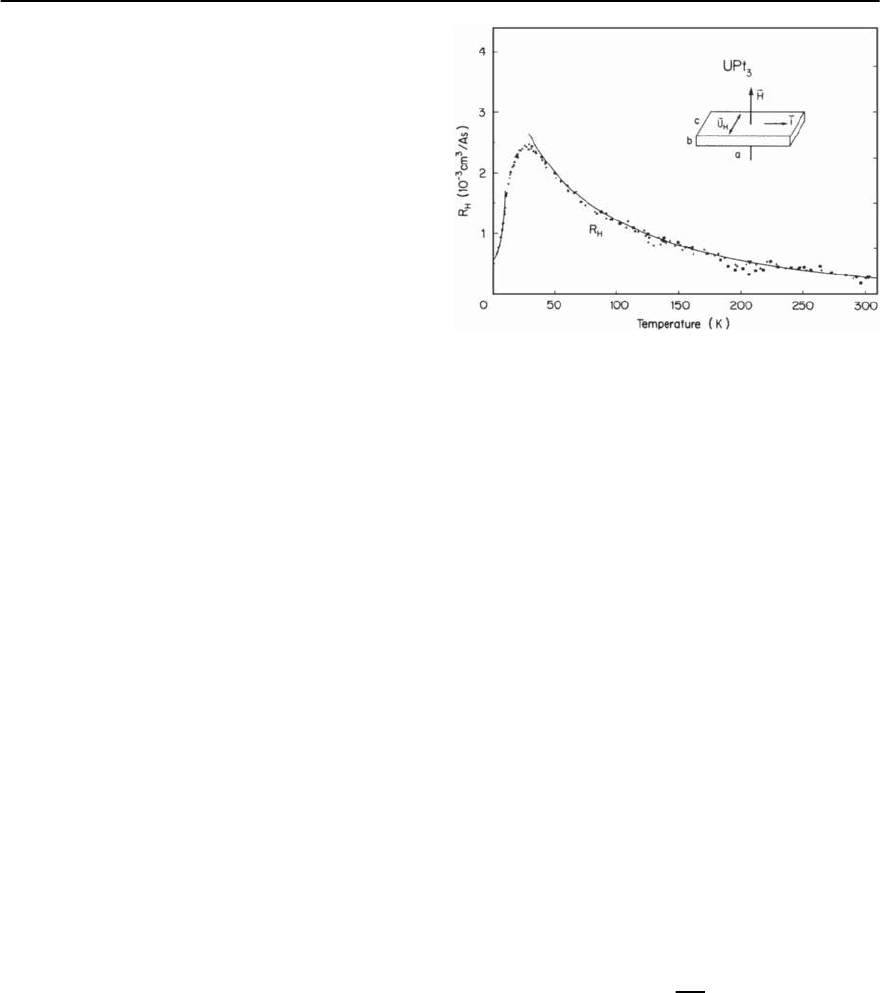
19 Heavy-Fermion Superconductivity 1085
The Hall Effect
The application of a static magnetic field perpendic-
ular to the direction current flow in a metal,produces
a voltage drop in a direction that opposes the Lorentz
force acting on the moving electrons. The Hall co-
efficient, R
H
, describes the dependence of the ratio
of the transverse electric field to the current on the
strength of the applied field. In conventional metals,
the Hall coefficient is almost temperature indepen-
dent and provides informationabout the density and
the sign of the charge carriers. However, in heavy-
fermion systems,the Hall coefficientis about two or-
ders of magnitude larger than in conventional metals
and is also highly temperature dependent. At room
temperature, the Hall coefficient is usually positive
and initially increases with decreasing temperature
and then goes through a maximum. The maximum
has been observed in CeCu
6
[249], CeCu
2
Si
2
[250],
UBe
13
[251] and UPt
3
[252]. The temperature de-
pendence of the Hall coefficient of UPt
3
is shown in
Fig. 19.40. For systems for which the resistivity has a
maximum, the temperatures of the maximum in the
Hall coefficients and the temperatures of the corre-
sponding resistivity maxima are comparable [249].
The high temperature variation of the Hall coeffi-
cient is interpreted in terms of the combination of
the usual Hall effect due to the Lorentz force and
also from skew scattering.The skew scattering results
from the scattering of conduction electrons from a
set of independent magnetic impurities. The skew
scattering involves the polarization of the moments
by the applied magnetic field which also produces
a spin-splitting in the impurity f density of states.
The spin-orbit coupling on the impurity results in
interference between the l =3andl =2angular
momentum channels [253]. The extreme sensitivity
of the narrow quasi-particle density of states at the
Fermi energy has been identified [254] as the source
of the very large magnitude of the Hall coefficient.
The anomalous skew scattering from independent
local moments does reproduce the high temperature
behavior of the Hall coefficient but fails to predict
the maximum in the Hall coefficient, which is fol-
lowed by a rapid drop at lower temperatures. The
drop in the Hall coefficient has been interpreted as
Fig. 19.40. The temperature dependence of the electrical re-
sistivity of the heavy-fermion compounds U
2
Zn
17
,CeAl
3
,
CeCu
2
Si
2
and UBe
13
.Theinset shows the low temperature
T
2
variation of the resistivity found in CeAl
3
signifying the onset of coherencebetween the fluctu-
ating parts of the local magnetic moments. In some
heavy-fermion materials such as UAl
2
,theHallco-
efficient changes sign at low temperatures. Similar
sign changes in R
H
can be found in materials that
have multi-sheeted Fermi surfaces.
Thermopower
It is expected that the low temperature limit of the
thermopower S should be un-renormalized by the
quasi-particle mass enhancement. Nevertheless, the
measurement is expected to reflect the strong inter-
actions as it should provide a measure of the loga-
rithmic derivative of the imaginary part of the self-
energy. This can be seen from the usual expression
of the linear T contribution in terms of the ratio of
two correlation functions
S =−ˇ
K
11
K
12
, (19.144)
where K
11
involves the time ordered current–current
correlation function, and K
12
involves the heat flux–
current correlation function

1086 P.S. Riseborough,G.M. Schmiedeshoff,and J.L.Smith
K
11
=
1
3
ˇ
0
d exp
i !
< T
j() . j(0) >,
(19.145)
K
12
=
1
3
ˇ
0
d exp
i!
< T
j
Q
() . j(0) >,
where j
is the current density and j
Q
is the heat flux.
The Seebeck coefficient can be approximately evalu-
ated as
S =−
1
|e|T
I
(1)
I
(0)
. (19.146)
When the above expression is analyzed using the
Sommerfeld expansion, one finds the relation
S =
2
3
k
2
B
T
|e|
∂ Im£(E)
∂E
Im £(E)
E=0
, (19.147)
which also shows that S should vanish linearly with
T at low temperatures. The measured thermopow-
ers show considerable variation both with com-
pound and with temperature but do share one com-
mon characteristic, which is that the magnitude of
S is about an order of magnitude larger than com-
mon metals. At 4 K, the thermopower of UBe
13
is
−11VK
−1
[255] and has decreased to −25VK
−1
just below 1 K where the superconductivity sets in.
At high temperatures,the thermopowers of CeCu
2
Si
2
[2] and UAl
2
[256] are both positive,andhave magni-
tudes of 15 VK
−1
and 40 VK
−1
, respectively, while
in the same temperature range S for UPt
3
is neg-
ative with a magnitude of about −12 VK
−1
.The
compound CeCu
2
Si
2
has a shallow maximum in S
of about 20 VK
−1
at 170 K, which seems to be con-
nected with the crystal field splitting observed in this
compound, while the thermopower of UPt
3
appears
to have an even shallower minimum of −12 VK
−1
near 200 K.The thermopower of UPd
2
Al
3
is large and
showsa monotonic decrease withdecreasing temper-
ature [257]. These slow variations of S in the high
temperature region, are to be contrasted with the
variations [258] found in CeCu
6
and CeAl
3
,where
S decreases from about 40 to 10 VK
−1
as T is in-
creased from 50 and 300 K.The thermopower of UPt
3
changes sign at 24 K,and has a positive peak at about
8 K. The thermopower in CeCu
2
Si
2
changes sign at
75 K from positive to negative with decreasing tem-
perature, and there is a deep minimum (−35VK
−1
)
at 20 K near the cross-over temperature. This is fol-
lowed by a small positive maxima at a temperature
of 0.2 K. The thermopower of CeAl
3
[259] is simi-
lar to CeCu
2
Si
2
in that it goes through a minimum
(−4VK
−1
at 3.5 K), changes sign near the crossover
temperature, and shows a small positive maximum
at an even lower temperature ( ∼ 0.3 K ). However,
CeCu
6
has three positive maxima [258], while UAl
2
only shows one negative minimum before tending to
zero linearly with T [256]. This rich variety of be-
havior is not reconcilable with the behavior of a sin-
gle impurity Kondo model in which the scattering is
dominated by the position of the Kondo resonance
with respect to the Fermi-level.For Ce impurities,the
model predicts that S has a positive maximum at the
Kondo or cross-over temperature and falls to zero as
T → 0. The richness of the low temperature varia-
tions of the thermo electric power, like the Hall effect
and the de Haas van Alphen measurements, suggests
that the electronic structure contains a number of
quasi-particle bands with high effective masses near
the Fermi energy.
Thermal Conductivity
The thermal conductivity of metals, unlike the elec-
trical conductivity, has contributions from the non-
equilibrium distribution of phonons as well as from
the quasi-particles. Thus, one may write
=
L
+
e
, (19.148)
where
L
represents the lattice contribution and
e
is the electronic contribution. There is no simple ex-
perimental way to decouple these two terms without
recourse to theory. It is expected that, at sufficiently
low temperatures, one will have
L
∝ T
2
, (19.149)
when the phonon scattering is due to electron–
phonon interactions,and if the mean free path is less
than the size of the crystal. Otherwise, one expects
L
∝ T
3
(19.150)

19 Heavy-Fermion Superconductivity 1087
when the phonons mainly scatter from the surfaces
of the crystal.At temperatures much greater than the
Debye temperature, T Ÿ
D
, one expects that the
lattice contribution to the thermal conductivity will
have the temperature dependence
L
∝
1
T
. (19.151)
These considerations lead one to conclude that,
at sufficiently low temperatures, the quasi-particle
contribution is the dominant term in the thermal
conductivity. The quasi-particle contribution to the
thermal conductivity is usually written as
e
=
2
9
k
B
T
v
2
qp
(E)
E=0
, (19.152)
where is the scattering rate, and v is the quasi-
particle velocity ( ∼ Z
0
and v ∼
k
F
Zm
b
). The two
factors of the mass renormalization Z, occurring in
the quasi-particle velocities, are expected to cancel
with a similar factor in the quasi-particle density of
states and also with one factor of Z in the quasi-
particle lifetime. Hence,the overall magnitude of the
electronic contribution of the low temperature ther-
mal conductivity should not differ significantlyfrom
that of a normal metal,for reasons similar to why the
d.c. electrical conductivity is also unrenormalized.
Thus, one expects that the Lorentz number, L(T), de-
fined by
L(T)=
e
(T)
T (T)
(19.153)
should have a value similar to the value L
0
predicted
for purely elastic scattering
L
0
=
2
3
k
B
e
2
. (19.154)
For purely elastic scattering, the Lorentz number, in-
volving the ratio of the appropriate conductivity ten-
sors, is expected to be isotropic. Since inelastic scat-
tering results in a reduction of the quasi-particles’
energies, in addition to the reduction in the quasi-
particle current, the Lorentz number is expected to
be reduced below L
0
when inelastic scattering is also
present. Since stoichiometric heavy-fermion mate-
rials often show sizeable T
2
terms in the low tem-
perature electrical resistivity which are attributed to
(inelastic) electron–electron scattering, one expects
that when the T
2
term is larger than the residual re-
sistivity, L(T)shouldhaveavalueclosetothatfor
purely elastic Baber scattering [260]
L
elas
= L
0
36
2
−3
. (19.155)
However, for lower temperatures such that the
quasi-particle–quasi-particle scattering term be-
comes negligible compared with the residual resis-
tivity, one should recover higher values of L(T)close
to the Lorentz number L
0
. These expectation are
very nearly borne out by experiments on the nor-
mal states of CeAl
3
,CeCu
6
,CeCu
2
Si
2
and UPt
3
.In
CeAl
3
[259,261, 262], the Lorentz number exhibits
a minimum value of 0.75 L
0
at 0.5 K, which is larger
than the theoretical limit of 0.65 L
0
,anditovershoots
the elastic limit yielding a weak maximum at 1.1 L
0
at 50 mK. The temperature of the minimum roughly
agrees with the temperature where the T
2
term dom-
inates the resistivity. For CeCu
6
,theLorentznumber
falls to a minimum value smaller than L
0
at a temper-
ature of about 0.3 K,which is close to the temperature
of 0.15 K where the T
2
term in the resistivity first
becomes apparent as it cools [263].The extrapolated
data show that L(T)approachesL
0
at20 mK,in agree-
ment with the arguments concerning the freezing out
of the inelastic scattering processes.For CeCu
2
Si
2
,the
low T value of L(T)appearstobeL
0
[2,264].At low
temperatures, the inferred phonon contribution to
L
of CeCu
2
Si
2
has a T
2
variation [264] as expected
from electron–phonon scattering. The phonon con-
tribution
L
starts to become larger than the elec-
tronic component at the temperature of 1 K where on
cooling the T
2
term in the resistivity first becomes
apparent [264].For UPt
3
,the minimum value of 0.45
occursat a temperature of the order of 2 K [216,265].
Since UBe
13
does not form a Fermi liquid, it is not
surprising that the Lorentz number is not constant
but instead varies approximately linearly with tem-
perature [28,266].
For temperatures greater than the coherence tem-
perature, the Fermi liquid analysis of
e
is expected
to fail. However, in the temperature regime where
T > T
K
, one expects that Ce based heavy-fermion
materials will resemble a metal in which the con-

1088 P.S. Riseborough,G.M. Schmiedeshoff,and J.L.Smith
duction electrons scatter off of a set of independent
disordered magnetic moments. In this temperature
regime, the thermal conductivity from the electrons
may be calculated perturbatively [267].Theresult for
the Lorentz number L(T) can be approximately ex-
pressed in the form
L(T)=
1
e
2
T
I
(2)
I
(0)
−
I
(1)
I
(0)
2
, (19.156)
where I
(n)
is defined by Eq. (19.141). The Lorentz
number is also expected to depend strongly on the
crystalfieldsplittings [268].Thecrystalfieldsplitting
in CeCu
2
Si
2
is assumed to give rise to a minimum in
the Lorentz number at the temperature around 80 K.
In this high temperature regime, the Lorentz num-
ber can be appreciably greater than L
0
. This result
is caused by the large temperature induced shift of
the f density of states away from the Fermi energy
for T > T
K
.The experiments are consistent with this
trend: However, the lattice contribution to
L
is no
longer negligible and may be several times greater
than the quasi-particle contribution. This hypothe-
sis is supported by the comparison of measurements
on CeCu
2
Si
2
with the reference material LaCu
2
Si
2
.
In fact, if the phonon contribution
L
is completely
ignored in the data analysis, the Lorentz number is
about a factor oftwenty times greater than L
0
.Thein-
ferredpresence of a large phonon contribution is also
supported by the conclusion that the theoretical cal-
culated values of L(T),using the independent Kondo
impuritymodel,areunabletoaccountforelectronic
contributions to L(T) ofthismagnitude.Likewise,for
UPt
3
,the phonon contribution has been identified as
being important above3.5 K [29] and may be respon-
sible for up to a maximum of 4.5 L
0
of the Lorentz
number at T = 24 K inferredfrom the raw data [216].
The Lorentz number for CeCu
6
, in the high temper-
ature regime [269] qualitatively resembles L(T)for
UPt
3
, having a maximum at T ∼ 20 K where it at-
tains a value of about 2.5 L
0
but falls towards L
0
at
higher temperatures.
Ultrasonic Attenuation
Ultrasonic experiments measure the attenuation and
velocities of sound waves and, through the electron–
phonon interaction, provide information about the
electronic system. At temperatures much lower than
the Debye temperature, the attenuation of the sound
wave due to anharmonic phonon interactions should
be negligible, and the electron–phonon interaction
should provide the dominant contribution to the at-
tenuation.In this case,oneexpects a strongsimilarity
between the ultrasonic attenuation coefficient and
the electrical conductivity. Just like the optical con-
ductivity (!) yields the lifetime of a photon, the
ultrasonic attenuation ˛
q, ˆ
(!) yields the lifetime of
a phonon. This similarity is expected since, for many
purposes, the effect of a phonon can be interpreted
in terms of the effect of the accompanying electric
field. In analogy with the conductivity, one expects
that in the limit q → 0, the renormalization of the
scattering rate will cancel with the mass enhance-
ment. Thus, in the long wavelength limit, the ultra-
sonic attenuation is expected to be unrenormalized.
The most noticeable difference between ultrasonic
attenuation and optical absorption occurs through
the extremely different magnitudes of the velocities
of the corresponding waves. If the conditions allow
the heavy quasi-particles to co-move with the sound
wave, it becomes possible for the quasi-particles to
surf-ride and continuously absorb energy from the
sound wave. For example, if a longitudinally polar-
ized sound wave with phase velocity
!
q
propagates
through a gas of heavy quasi-particles, it strongly
perturbs the quasi-particles with velocities almost
parallel and almost equal to the phase velocity of
the wave. In the frame of reference traveling with
the wave, the quasi-particle is at rest and experiences
an essentially time independent electric field. The
electric field continuously transfers energy from the
wave to the quasi-particles that have the same ve-
locity. If there is a slight mismatch in the velocities,
quasi-particles with lower velocities than the wave
draw energy from the wave and accelerate, whereas
quasi-particles that are moving faster lose energy
and slow down. This results in the rate of energy
loss of the wave being proportional to the derivative
of the distributionof quasi-particle velocities,which
is evaluated at the velocity of sound.At temperatures
below those at which the heavy quasi-particles are
being formed, the Fermi velocity is comparable to
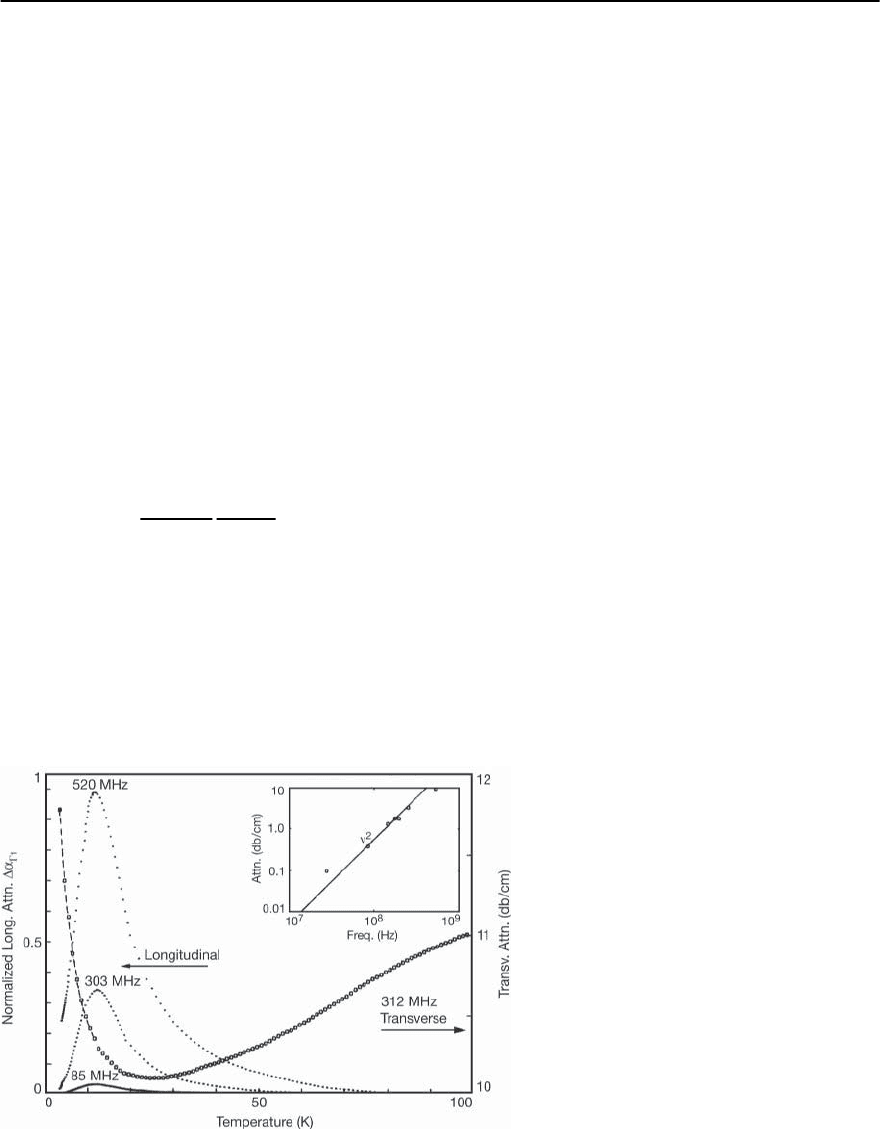
19 Heavy-Fermion Superconductivity 1089
the sound velocity in contrast to normal metals. So
the attenuation of sound waves may be expected to
be larger than in ordinary metals. On the other hand,
due to the approximate equality between the sound
velocities [270], the Born–Oppenheimmer approxi-
mation no longer applies and the sound wave may
have to adjust adiabatically to the quasi-particles’
motions.The induced couplingof the phonon modes
can also lead to damping. It is found that the ultra-
sonic attenuation for CeCu
6
,UPt
3
, and UBe
13
have
magnitudes comparable to that of ordinary met-
als [27]. This suggests that the magnitude of the cou-
plingbetweenthequasi-particleandsoundwaveis
reduced from that observed in normal metals due
to the appearance of vertex corrections. Neverthe-
less, the strong electron–phonon coupling shows up
in other elastic properties.In ordinary metals,the at-
tenuation is relatively featureless and is described by
aDrude-likeformula,
˛(!)=
!
2
1+!
2
2
2
()
c
3
, (19.157)
where is the electron–phonon coupling, c is the ve-
locity of sound, and is the mass density. In heavy-
fermion compounds at high temperatures, the mag-
nitude and frequency dependence of the attenua-
tion is reasonably similar to normal metals.However,
anomalous temperature dependences are observed
in the low temperature quasi-particle phases. The
temperature dependence of the attenuation of lon-
gitudinal sound in UPt
3
shows an anomalous peak at
12 K [271], and has an amplitude that scales with the
square of the frequency of sound. The temperature
dependence of the attenuation coefficient is shown in
Fig.19.41.Sincetheanomaly is only present intheab-
sorption of longitudinal sound but not of transverse
sound, the origin of this peak has been ascribed by
Schotte et al. [272] to the existence of a breathing
mode. In the breathing mode, the lattice adjusts lo-
cally to the state of the f ion,and vice versa.Thus,the
sound waves are coupled to the heavy quasi-particle
bands.This type of coupling is also expected to mod-
ify the phonon dispersion relations due to hybridiza-
tion with the quasi-particle bands. At temperatures
above 12 K, the heavy quasi-particle masses have
not fully formed, and so the coupling becomes in-
coherent. Thus, the effect of an increase in tempera-
ture results in a reduction of the attenuation coeffi-
cient. Since in the model of Schotte et al. the sound
wave mainly couples to the thermally excited quasi-
particles, the coupling is ineffective in attenuating
sound at temperatures lower than 12 K. Therefore,
the sound wave attenuation diminishes for tempera-
tures lower than the peak temperature. At still lower
temperatures,but still in the normal state,the attenu-
ation coefficient ofUPt
3
decreases proportional to T
2
with increasing temperatures [30]. This is indicative
of the T
2
dependence of the quasi-particle scattering
Fig. 19.41. The temperature dependence of the
transverse (312MHz, q b, uc) and longitudi-
nal ultrasonic attenuation coefficients ˛( )of
UPt
3
at various frequencies . The longitudinal
data are normalized to the 520 MHz peak. The
inset shows the
2
dependence.[After M¨uller et
al.[271]]
